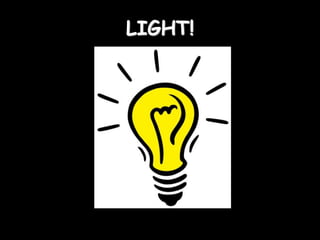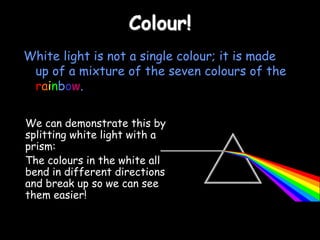Light 2 refraction and col
- 1. LIGHT!
- 2. How does light travel through air? water? How do you think light travels through oil?
- 3. Experiment 1. Draw three glasses of water in your copy, one empty, one filled with water and one filled with oil. 2. Put a pencil in your glass while it is empty and draw what you see when looking straight on. 3. Put water in your glass and look again. Draw what the pencil looks like now. 4. Add oil to the top of the water and draw how the pencil now looks.
- 4. An empty glass (air)
- 5. Look at how light passing through water makes the pencil look like it’s bent!
- 6. A glass with water and oil Light bends more when passing through oil than it does passing through water!
- 8. Colour! White light is not a single colour; it is made up of a mixture of the seven colours of the rainbow. We can demonstrate this by splitting white light with a prism: The colours in the white all bend in different directions and break up so we can see them easier!
- 9. The colours of the rainbow: Red Orange Yellow Green Blue Indigo Violet
- 10. Seeing colour The colour an object appears depends on the colours of light it reflects. For example, a red book only reflects red light: White light Only red light is reflected
- 11. A pair of purple trousers would reflect purple light (and red and blue, as purple is made up of red and blue): Purple light A white hat would reflect all seven colours: White light
- 12. When mixing paint colours we mix blue and red and make purple, yellow and red make orange and yellow and blue make green. BUT!!! When mixing coloured light, we get different colours altogether!!
- 13. Experiment Time! Attach one colour to the light. Then shine your new ‘coloured bulb’ through a coloured filter and see what colour you make when you mix the colours! ???
- 14. What do you think happens when you mix all the colours together?
- 15. Adding colours White light can be split up to make separate colours. These colours can be added together again. The primary colours of light are red, blue and green: Adding blue and red makes magenta (purple) Adding blue and green makes cyan (light blue) Adding all three makes white again Adding red and green makes yellow















